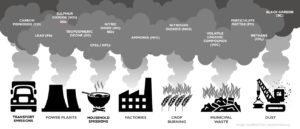
Air pollution has been identified as one of the major threats for the environment and which affects everyone such as human beings, animals, crops, cities, forests, aquatic ecosystems just to name these few.
Environmental experts say air pollution is caused by the presence in the atmosphere of toxic substances, mainly produced by human activities and which also result from natural phenomena such as volcanic eruptions, dust storms and wildfires.
According to statistics released by the World Health Organization (WHO), close to 7 million people die every year from exposure to polluted air. Ambient air pollution alone caused some 4.2 million deaths in 2016, while household air pollution from cooking with polluting fuels and technologies caused an estimated 3.8 million deaths during the same year.
In the same vane, the UNICEF report outlines that, outdoor air pollution deaths increased from 164.000 in 1990 to 258.000 in 2017, and with population, industrial, and consumption growth potentially increasing, the levels of pollution will subsequently increase. Projections estimate that Africa’s population will double by 2050 from 1·2 billion. More than 80% of that increase will occur in cities, leading to increased traffic and hence air pollution.
Yet, addressing threats of air pollution through-out a series of mechanisms and by the way highlighting its impacts on the various sectors of life has been developed in a recent module labelled Air quality communication in Africa.
As underscored in the module, the aim is to help African cities and countries develop an effective communication strategy in order to inform, educate, and strengthen stakeholders’ participation in all aspects of air quality management (AQM), to prevent and reduce air pollution.
Added to the aforementioned aim, the module is equally out to advise public air quality managers with little expertise in communication, as well as public communication staff with little knowledge of air quality; and all interested stakeholders working to enhance air quality data and promote actions to improve air quality in the continent.
With the current COVID-19 health threats, this module on Air quality communication is more of an advocacy tool for African governments and all stakeholders. Africa can be spared a host of respiratory illnesses, including COVID-19, through clean air but air pollution data across the continent that could influence policy is of poor quality or inaccessible, making efforts to track air quality difficult.
Despite the fact that air pollution is a worldwide threat, African countries are greatly affected. Tunisia, Morocco, Zimbabwe, Kenya, Ethiopia, Egypt, Nigeria, Senegal, Ghana and Cameroon just to name these few countries, figure amongst those affected by pollution.
The module developed by a technical team recruited by the African bureau of the United Nations Environment Programme (UNEP), traces in a nutshell through-out 5 sections, the assessment of air quality communication capacity; Effective Air Quality Communication: Co-benefits and solutions for air quality; Air Quality Communication Plan; Roadmap for Air Quality Communication and how to improve overall effectiveness of air quality communication.
The module states that: “Policymakers must understand the need for education programs aimed at making citizens aware of sources of air pollution and related health risks. The environmental management authorities need to direct efforts on risk communication strategies to motivate personal direct perception or awareness of an environmental problem such as air pollution. This approach enhances the individual’s understanding of the importance of environmental policy measures, which makes such measures easier to accept by the community and also enhance personal response in reducing exposure to pollutants. There is also need for further research on community perceptions to help understand factors shaping people’s perceptions.”
Talking of the overall content of the module, emphasis is laid on the various sections developed by the communication crew. Section one deals with the assessment of air quality communication capacity. Focus here is on the need to develop and implement communication strategies, ensure availability and access to air quality information to stakeholders, and promote the proper the use of appropriate communication platforms.

In Section two, focus is on effective air quality communication. It has to do with identifying and describing the key factors involved in effective air quality communication; determining communication objectives; and learning different ways to share information through campaigns, citizen science, and social marketing.
“Communication is key in Air quality management. Information about air quality is required to raise public awareness, strengthen policies, influence behavior and ultimately reduce emissions of air pollutants. Communication is an essential part of AQM because the adoption of air pollution control measures will only be effective if decision makers, key stakeholders and the general public understand the importance of the intervention. Air pollution is the number one global environmental risk to public health, and a growing priority on the agenda of number of public authorities and regional bodies as well in Africa with progressive action taken to clean the air.” As stated in the module.
Meanwhile in section three is dedicated to communicating actions that will improve air quality and emphasis is placed on co-benefits and solutions.
Communication experts say effective air quality communication is not limited to explaining the status of air (informing) and raising public awareness on air pollution impacts. One of the main objectives or indicators of effective communication as underscored in the module, is to observe a change in behavior which can happen more likely if the person understands what the change in behavior is for, and how it can specifically be done. This process is accompanied by several mechanisms and communication tools well identified by experts.
The proper management of air pollution gives roots to multiple benefits, given the wide extent of negative impacts it has on human beings and the environment. Reason why, through-out the module it has been highlighted that air quality improvement requires a combination of approaches depending on the objective and target audience. To morph our governments, there is need to channel out the various benefits of improving on the quality of air. Slowing down the rate of climate change, improving public health and increasing food production are vital.

In section four of the module based on air quality communication plan, key elements are been reviewed in order to help governments put in place effective communication strategies. The communication plan is the bedrock of the entire strategies that will be undertaken. It plays a key role in ensuring the implementation of government actions to address this issue.
“An appropriate communication strategy or plan is necessary to inform the public, educate specified stakeholder groups, and strengthen stakeholder participation in all aspects of AQM. Monitoring and evaluation should be conducted throughout the implementation of the strategy or plan.”
An air quality communication plan lies on some key points being: Identifying target group; Determining types of information needed; Formulating and testing key messages; Identifying the means of communication; Planning and budgeting; Engaging stakeholders and implement communication plan; Evaluation.
Section 5 focuses on challenges in air quality communication and the Guidance Framework roadmap. Here as observed by experts, there are several key challenges in air quality communication which still hinders effective communication of air quality information. We can note amongst other, limited capacities from our institutions (governments) to grant air quality information to the public; limited coverage on the issue which creates a technical management gap and limited financial resources.
With such hindrances, actions aimed at seeking for proper air quality management are null and void.

The significant studies carried out and released in the module are expected to act as an appropriate tool to be harnessed by governments and municipalities faced with challenges of air pollution in Africa. Advocacy campaigns or moves should be stressed much on the need to acquire the module as a strategic weapon for an effective communication in the change of mindsets.
However as indicated by communication experts, to move towards a fully developed air quality communication program, air quality information needs to be clear, comprehensive, accurate, precise, understandable and relevant.
Elise Kenimbeni




